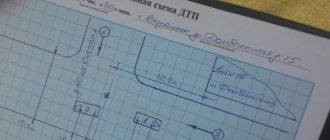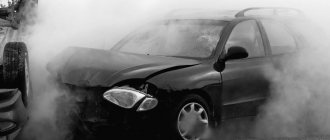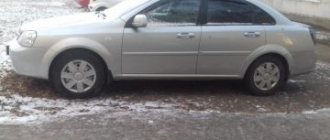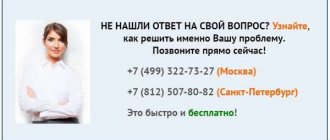OSAGO - what is it?
Compensation for damage and risks provided for in MTPL insurance is the basic principle of insurance. There is such a term as “automobile liability”, which is determined by the provision of a policy that covers the actions of its owner in relation to other participants in the road process when an insured event occurs. For example, the owner of a car caused damage to someone else’s vehicle, or because of it, other participants in the accident on the road were injured, and in this case, all losses that need to be compensated are the responsibility of the insurer directly.
There are established limits on the amounts that an insurance company can pay:
- When compensating for damage to the car—RUB 400,000.
- For compensation for damage to health—RUB 500,000.
As you can see, the amounts are quite impressive, and in order to avoid compensation, insurance companies try in every possible way to reduce them.
What to do if you don’t agree with the amount of insurance after an accident
Since insurance companies are commercial entities, they often try to save on payments. This occurs by underestimating the amount of damage by excluding individual damage from the report. Having received a refusal decision, or if you disagree with the calculation of compensation, you must contact an independent appraiser. To conduct a vehicle inspection, all parties to the dispute are notified, including the person at fault for the accident and the insurer. The appraiser's conclusion can be referred to when contacting the insurance company, the ombudsman for compulsory motor liability insurance, or the court.
Who is eligible for insurance compensation?
Various incidents occur on the road, and regardless of who the MTPL policy was issued for, who was driving the car and who actually is its owner, compensation will be paid to the following representatives:
- The owner of movable property, regardless of the fact that he was driving at the time of the accident.
- A person who has a power of attorney from the owner of the vehicle to pay compensation.
- To the heirs of the car owner if he died as a result of an accident.
Such rules, according to compensation payments, apply to cases where one of the cars was damaged in an accident. But what happens if an accident affects two cars and two of their owners at once?
Here's what:
- Payment of compensation from insurance agents, the amount of which is 50% of the full insurance.
- Refusal to provide insurance payments to two participants in an accident at once, if it was not possible to establish who was at fault for the incident. This is provided for in the Civil Code of the Russian Federation in Article 1083, which states that the payment of compensation in case of an accident occurs only after the owner’s guilt and the degree of the offense have been established. And if both drivers are at fault, then identifying which of them is the culprit is quite problematic.
If two cars and their owners were damaged in an accident, and the insurance company refuses to compensate for losses, then each of the car owners can go to court to establish and protect their rights.
What to do if the insurer refuses to pay cash
Getting a cash refund is not easy, but it is possible. The driver should come to a common denominator with the insurer and agree to the conditions and amount that suit both parties. The insurer has the right to refuse to pay in money, but there must be clear reasons for this. Another case is if on his part there were facts of violation of the requirements under the current legislation. Here, the alternative would be to file a lawsuit asking for monetary compensation for damages.
Receiving compensation in stages
Receiving compensation occurs in two ways:
- Giving money instead of repairs.
- Carrying out restoration work on the car and paying for it.
Which method to choose is a personal decision of the applicant.
Since 2014 and to this day, there have been innovations in the rules regarding compensation payments.
First of all, the changes affected the following points:
- If the damage to a car that was caused to it as a result of an accident is estimated at 400,000 thousand rubles, then compensation is paid in full, and not in relation to the degree of damage.
- If people were injured as a result of an accident, then each of them is owed 500,000 thousand rubles.
- If, as a result of an accident, the owner of the car died, then his heirs are due compensation in the amount of up to 500,000 thousand rubles. From this amount, 25,000 thousand rubles are immediately paid to pay for funeral services. The closest relatives of the deceased receive maximum compensation, and then divide it among themselves at their discretion.
- Car wear and tear should not exceed 80%. The degree of depreciation of the car body is calculated based on the warranty date, and tire replacement occurs only after the projector dimensions have been measured. Plastic parts of the car are calculated according to the maximum level of wear, and other parts are calculated depending on the age of the car.
ATTENTION !!! If, in 2021, instead of repairs, the applicant demands compensation in cash from his insurance company, he needs to contact the inspectorate and get from them a certain certificate, which must include all the main descriptions of the incident that occurred on the road.
For example, such a certificate indicates in what state the owner of the car was at the time of the accident, was in an alcoholic state, or violated traffic rules. But these are not all the descriptions that a certificate issued by the State Traffic Inspectorate may contain. Sometimes insurance companies require you to submit, so to speak, an extended certificate for consideration, which should describe all the small details of the accident that occurred.
What is extended help?
If the insurance company requires an extended certificate, it must contain the following data:
- Information about all participants in the incident.
- Information about the place of residence of car owners, their full initials and data indicated on the driver’s license, as well as vehicle numbers.
- Evidence that at the time of the road accident, both drivers were in adequate condition and were not under the influence of alcoholic beverages or drugs.
An extended certificate takes much longer to prepare than a regular one, but this is understandable, since it also contains more information. When an applicant demands from an insurance company to compensate for damages from an accident, certain problems may arise, since the insurer has every right to demand the opinion of the judicial authorities from its client. This can happen if fraudulent manipulation is suspected.
Europrotocol and its effect
The Europrotocol gives the right to register an accident using a standard and simple form. This is acceptable if no one was injured as a result of the incident, and both participants do not mind drawing up a report. As a rule, in such cases, all problems associated with an accident are resolved directly at the place where it occurred, and the presence of the police is not required. The amount of compensation in such situations cannot be more than 50 thousand rubles, and for residents of Moscow and St. Petersburg they can reach up to 400 thousand rubles. In order for compensation to be paid to the maximum extent, participants in an accident must provide the insurance company with all the details, video or photos, in which the damage to the cars can be clearly seen, for examination.
ATTENTION !!! OSAGO has clause 3.5, which states that both participants in the accident are required to draw up a notification about the accident, even though the inspection staff also draw up a certain protocol. In this case, each driver separately fills out his notice, in which he describes all the reasons for writing it. But, if two vehicles were injured in an accident at once, and there are no disagreements between their owners, it is possible to sign only one form.
There are times when the insurance company does not agree with the facts that were provided to them by the participants in the accident, and then they need to ask for help from experts.
Basic information about penalties under compulsory motor liability insurance
Moments when a victim in an accident has the right to claim a penalty under compulsory motor liability insurance:
- A decision on compulsory motor liability insurance was not made within the time stipulated by law.
- Payments are made later than provided for by the MTPL law.
- The car restoration deadlines were not met.
- Underestimated amount of insurance compensation.
- Wrongful refusal to pay.
- Refund of the insurance premium (fee for the MTPL policy) upon termination of the contract in violation of the terms (14 working days).
Let's look at how to calculate the amount of the penalty:
- Penalty under compulsory motor liability insurance for violation of deadlines for making a decision and paying compensation. According to the law, for any delay there is a penalty of 1% per day of the amount of unpaid compensation. It is calculated as follows: the number of days of delay multiplied by the amount of insurance compensation and by 1%.
- Fines for violation of vehicle repair deadlines. The time frame within which the car must be restored is indicated by the insurer in the direction for repair; by law, 30 days are allotted for this. If the time frame for restoring the car is exceeded, and the victim did not give written consent to this, you can recover a penalty from the insurer. In this case, the penalty is 0.5% per day of the cost of repairing the car.
- Fine for underestimating the cost of damage caused. In this case, the penalty is 1% per day of the amount of additional compensation. It is paid by decision of the judicial authorities. In this case, the number of overdue days is counted from the moment the principal amount is paid.
- Wrongful refusal to pay. After a court decision is made, you have the right to a penalty of 1% of the amount of compensation for each day of delay. The number of days in this case is calculated from the day the refusal is received until the funds are transferred by court decision.
- Penalty for delaying the return of insurance premiums under a terminated MTPL policy. The MTPL rules stipulate situations when a policy can be terminated before the expiration date, as well as the procedure for returning part of the unused insurance premium to the policyholder or his legal representatives. The insurance company is obliged to return the money within 14 days of receiving the application for termination or automatic termination of the contract. The fine in this case is 1% for each day of delay.
Other options for action in case of an accident
In the event of an accident, you can use an additional CASCO insurance policy. It requires that an employee of the insurance company be present at the scene of the accident. A representative of the company inspects the vehicle and assesses the extent of the accident. Afterwards, he proceeds to drawing up a protocol and notifies the insurance companies whose services are used by the participants in the accident. If, in the opinion of the accident assessor, it is necessary to invite the traffic police, then they are called to the scene of the incident, also study the situation and make an approximate projection of the accident that occurred, and this may be needed by insurance companies in the future. If, as a result of assessing the accident, the culprit is found, then administrative liability and a fine are imposed on him, as well as other sanctions, depending on the specific case.
Drawing a conclusion, we can establish that in order for the insurance company to make compensation after an accident, it is necessary:
- Notify the insurance company and traffic police representatives about the incident.
- Wait until they arrive at the scene of the accident.
- Receive a certificate of an accident, which is provided by traffic police officers. It is issued at the nearest service branch.
- Collect the necessary documents and submit them to the insurance company. If the documents are submitted by the culprit of the accident himself, then he must present all the necessary papers for study no later than three days after the incident occurred. If this is not done, the company that issued the insurance may exercise its legal right and resort to recourse.
Also, the following package of documents must be supported by:
- Applicant's passport.
- Driver's license.
- An identification number.
- Passport for the car.
- Certificate from the traffic police.
- Insurance policy.
- Conclusion of medical staff.
At the request of the insurance company, you may also need a power of attorney to drive a car if the driver was not the owner himself, as well as a statement of expenses incurred after the accident, which include tow truck services.
Payments - how to apply for them correctly
Changes made to the legislation require that an applicant for compensation apply directly to the company that insured his car. But, as with any rule, there are exceptions to this too.
The policyholder is obliged to submit a request for compensation for damage to the insurer who issued the insurance policy to him if:
- At least two vehicles were damaged in the accident.
- There was no harm to the health of those involved in the accident.
- The owners of the accident have compulsory motor liability insurance on their hands, the effect of which has not yet ended.
If all of the above conditions are not met, then the application is submitted to the company that issued the policy to the person who caused the accident.
This happens in the following situations:
- More than 3 vehicles were injured in the accident.
- The person was injured.
If the person who was found guilty of the accident did not sign a contract with the insurance company, which stipulates that all injured participants in the accident have the right to receive direct payments, then the request for compensation leads to a negative answer. What to do? Submit an application directly to your insurer, who will compensate for losses, and after that, the fund of the Russian Union of Auto Insurers will return the funds spent.
In the event that the company that took out the insurance was deprived of the right to work or was declared insolvent, then again the RSA can handle the payment of compensation.
If the culprit does not have compulsory motor liability insurance or its validity has expired, then it is necessary to sue him in court, the damage caused by him will be paid by the same RSA, and a fine will be imposed on him to pay for moral damages.
If the victim does not have compulsory motor liability insurance, and there may be several reasons for this - a new car, the old policy has expired, then he still has the right to claim compensation.
Types and amounts of payments under compulsory motor liability insurance
The essence of insurance is that if the culprit has compulsory motor liability insurance, all financial costs to the injured party are reimbursed by the insurance company, since the owner of the policy himself may be insolvent, receive serious injuries or even die.
If the at-fault party does not have insurance, the insurance company will deny payment to the injured party.
The types, procedure for calculation and terms of payments are determined by Federal Law No. 40 of April 25, 2002 “On compulsory insurance of civil liability of vehicle owners,” which, as of 2021, provides for the following types and limits of payments:
- Compensation for damage caused to the victim’s property - up to 400 thousand rubles .
- Compensation for harm to health - the maximum payment does not exceed 500 thousand rubles .
- Depending on the specific situation, compensation for average earnings, funeral expenses, and compensation for the family in case of loss of a breadwinner are paid.
Payments under compulsory motor liability insurance are made only upon the occurrence of insured events specified in the contract.
Not only drivers are entitled to compensation. You have the right to receive compensation both if you are an injured passenger in a vehicle and if you are an injured pedestrian. These factors do not affect the terms of collection and the total amount.
Attention! OSAGO does not provide compensation for moral damage; it is intended only to compensate for property damage and harm caused to health or life.








